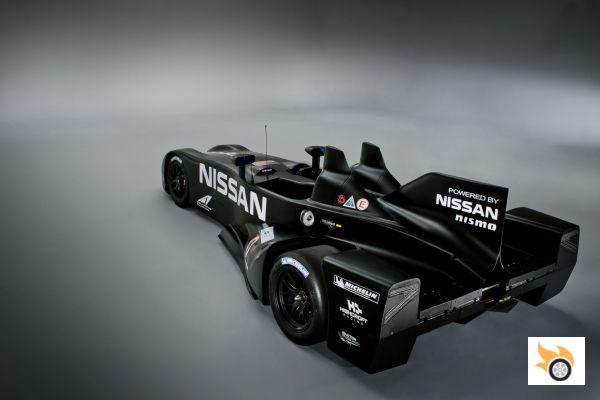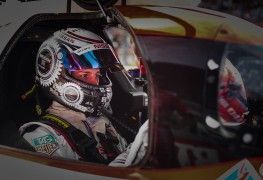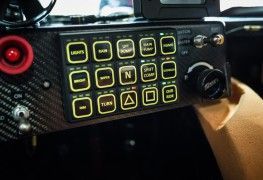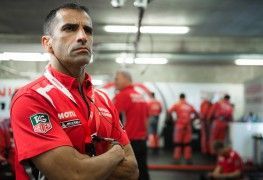At that time Ben Bowlby was the technical director of the Chip Ganassi team, and he had a mental clairvoyance. He imagined a car radically different to anything known, a car without spoilers, that would generate all its downforce in its underbody, through ground effect, and that would have less drag than any concept created to date.
Bowlby began working on the project under the name "DeltaWing", to present his idea at the 2010 Chicago Motor Show, where the first prototype of the concept, in titanium gray, could be seen.
The DeltaWing was, as its name suggests, a vehicle in the shape of a triangle, a "delta", with a tremendously narrow front axle and a much wider rear axle. Bowlby's idea was to pass about 80% of the weight distribution to the rear axle, which limited the track width requirements on the front axle to avoid rollover.
There was not a single external spoiler, all the downforce came from the venturi effect produced in its underbody, which allowed racing with cars stuck "nose-to-ass", by eliminating the "dirty air" generated by the spoilers behind them, which eliminates the downforce to the chasing cars.
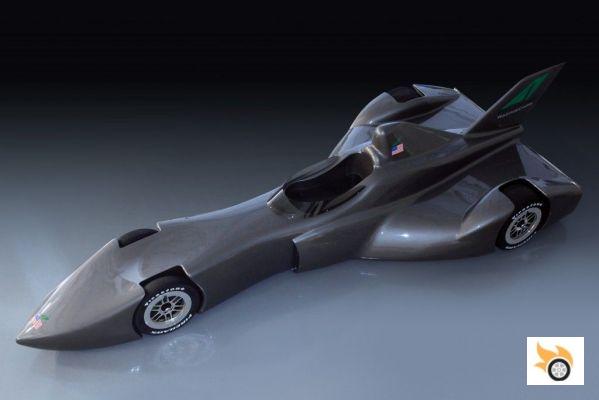
The design of the DeltaWing for Indy was groundbreaking, with more efficient, economical and also spectacular racing in mind, allowing the cars to run closer together without losing downforce.
Thanks to having a smaller frontal surface, the car also had an aerodynamic improvement, as it had less drag, which allowed it to use smaller engines, with lower fuel consumption, at the same performance.
In the original press release for the project, Bowlby promised a car that would be just as fast as the Indy cars of the time, but offering half the drag, half the production cost, half the fuel consumption, and would literally use half the size of a typical Indy engine (half the size, half the power, half the cost).
The audience was shocked. Some smiled at the idea of the DeltaWing as the Indy car of the future. And it was clear that if the car was chosen to move single-frame racing, it would be a visual game changer in the world of motorsport. However, it also had its detractors, and the decision-making group assembled by the Indy, the so-called ICONIC, was not in favor of changing the face of the championship so much, so despite the American national benefits that the DeltaWing was a Yankee project, they decided to go with Dallara's proposal, the car that would end up being called DW12.
It looked like 2010 was going to be the year where Bowlby would see the end of the road for his project. But Ben wasn't going to settle and give up so soon.
Bowlby began working on developing his idea along parallel paths. He first came up with and presented a concept for an open "Open Source" competition. Bowlby's idea was a championship where the DeltaWing was the starting point, and where each team and technical supplier could propose improvements to integrate into their chassis, improvements that would be offered to the other teams, and that would also be explained to the championship followers.
At that time Bowlby approached Don Panoz, the organizer of the ALMS (American Le Mans Series), to evaluate the organization of such a championship. The idea was motivating, but it seemed to require too much commitment from too many teams. Bowlby did not erase from his head in any case his precepts of "technological openness to the spectator", being clearly against the prevailing secrecy in a sport where races are basically won by machines.
But it would be something that was happening on the other side of the Atlantic, in France more specifically, that would change the fate of DeltaWing. In 2010 the ACO began to think of new ways to attract manufacturers and technological innovation to the 24 Hours of Le Mans. The problem for the ACO, when it was developing the new LMP1 rules with its fuel consumption limitation system, was in providing a media traction vector for the race at the same time. Someone within the organization came up with the idea of "Garage 56".
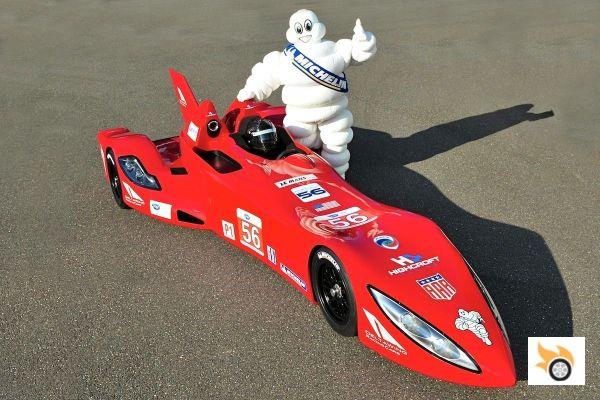
The ACO welcomed the DeltaWing as an entry for Garage 56 with open arms, even though the car was just a plastic prototype with no chassis or engine when it was shown in 2011.
The concept of "Garage 56" is simple: It is the admission of a team to participate in the 24 Hours of Le Mans with a car that does not conform to LMP or GT regulations, but offers a glimpse of interesting automotive technologies for the future, both for racing and for the civilian world. A team interested in participating in such a division would get the go-ahead from the ACO, who would modulate, along with the engineers, the performance of the car so that it would run more than an LMP2 but less than an LMP1.
While those were all the basic precepts originally, the ACO made no secret of the fact that Garage 56 could also be the media gateway for manufacturers who were committed to eventually racing in LMP1 in a few years time. After all, Garage 56 allowed for great media exposure, regardless of the car's performance.
Don Panoz encouraged Bowlby to enter into talks before the end of 2010 with the ACO. The ACO quickly saw that the DeltaWing project fit perfectly into their vision of a technological Le Mans, and quickly, still in secret, an agreement was signed to place the car on the 2012 Le Mans grid.
No one was saying anything officially, but Ben Bowlby slipped some media and acquaintances (including yours truly) a picture in early 2011 showing a DeltaWing with a roof and headlights. My first reaction was... "What the hell?". It was clear that the DeltaWing had mutated into an endurance car, but the reality was that there was no championship that could take it as such. Bowlby was teaming up with Don Panoz and the "All American Racers" team to build a car for which Michelin would make specific tires.
The project was announced to the crowd in the week leading up to Le Mans 2011, where a prototype of the roofless car was already on display in vibrant red. But the challenge lay ahead in full. Bowlby had just one render and twelve months to create an extremely rare car from scratch.
Things quickly turned upside down for him in 2011. Aston Martin was taking part as an integral manufacturer of an LMP1 car that year, having had some success with chassis developed by Lola. But the AMR-One turned out to be a genuine disaster. David Richards, through Prodrive (it's worth remembering that Richards is also a shareholder and director at Aston Martin), tried to take on too much, and as well as creating a completely new chassis, created a supercharged inline six-cylinder engine. The car turned out to be a complete joke.
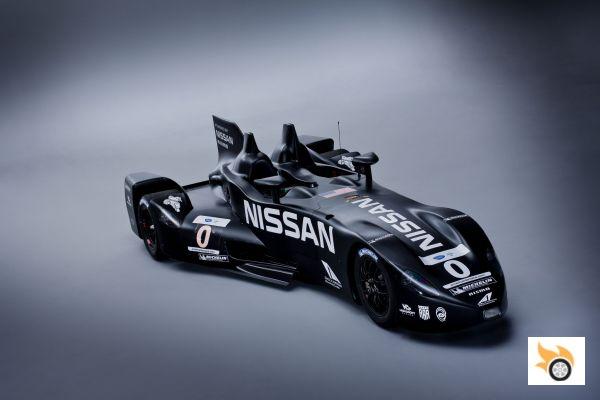
The starting chassis for the DeltaWing would be the one created by Prodrive for the Aston Martin AMR-One.
Prodrive didn't have the capacity to develop the supercharged two-litre inline six, and added to this the idea of launching the car into the race with virtually no experience miles, which resulted in an abandonment at Spa, and a much more painful one at Le Mans, where they could barely run four laps before the engine broke. With no financial resources available, the AMR-One project was immediately abandoned, and four chassis of the car were left without a Prodrive outlet.
It was just the opportunity Bowlby needed. The Briton contacted Richards, and acquired the AMR-One carbon fiber chassis as the basis for the DeltaWing. The car project had a starting point, in a much more economical way, and also with the guarantee of having an open chassis that was already homologated to many of the crash tests.
Obviously, there was a lot to change about the car, starting with the front end. Bowlby re-adapted his original DeltaWing plans to widen the central body of the car to match Prodrive's monocoque design. A whole new front section was created from this, in the form of a subframe, with a front track width of just 600 millimetres.
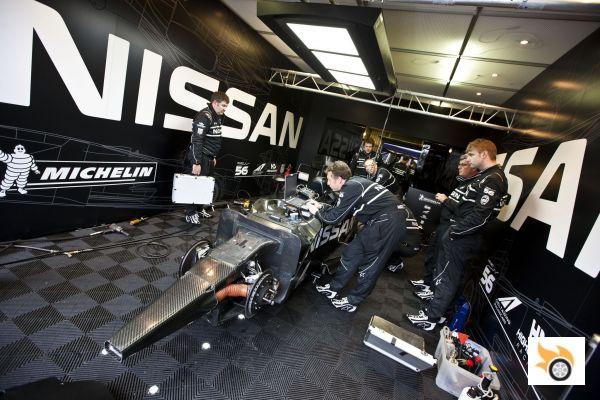
The front axle only had a 600 millimetre track, and used elements specifically developed for the occasion.
Like the design of any other car, Bowlby started by creating the desired geometry for the front end and developed the tyre, wheel and stub axle requirements from there. To save weight, he decided to go for a front stub axle fitted with a three stud bushing only, arranged in the same format as... from a Citroën 2CV!
As there were no suppliers who had rims, tyres or brakes available for this design, it was necessary to work on specific rims, fitted with Michelin 10/58 R15 racing tyres, i.e. 15 inches in diameter and only 100 millimetres in cross-section.
In Le Mans specification, only 25% of the DeltaWing's weight was to fall on the front axle. This meant that only 40% of the braking load would come from the front axle, which is much lower than normal. In any case, carbon-ceramic brake discs were fitted (especially grateful to work at high temperatures, produced by a particularly tight confinement on the front axle), bitten by rigid aluminium alloy calipers with four pistons.
The other big change to the car was at the rear axle, in the transmission. Bowlby was counting on using a much less powerful engine than the one designed by Prodrive, which should allow to lighten weight on the rear axle with a simpler gearbox. So a gearbox was developed from scratch by EMCO. It was a five-speed transaxle gearbox that weighed only 33 kilograms and integrated an active differential with yaw control. For this purpose, each gearbox output shaft to the rear wheels was equipped with an external gearbox. Both gears were connected by a longitudinal rod, the rotation of which was controlled by a servomotor. When the car took a curve, the difference in rotational speed of the wheel outside the curve with respect to the inner one was transformed into rotation of this longitudinal bar. Depending on the freedom of movement of this connection bar, granted by the electric servomotor, the car blocked more or released more the rear axle. The result is a car that can be more or less oversteering.
As Ben Bowlby explained in 2012, the car was designed as distinctly oversteering, allowing the driver to control the oversteer by countersteering and with the active differential working in his favor. Had Bowlby designed a more understeering car, he said, it would have been slower and more difficult to drive.
The gearbox was a bespoke development, with a differential with intelligent torque distribution.
To simplify the rear end design and not have to develop particularly expensive powertrain elements, Bowlby decided not to use the engine and gearbox as self-supporting elements, so he had to create a cage of chrome-molybdenum steel tubes to support the engine, gearbox and rear suspension.
At the aerodynamic level, the whole car was designed with maximum efficiency in mind, creating the downforce by ground effect, with large tunnels free of the problems of fixed regulations that the ACO does impose in other categories of prototypes.
But of course, the project had to be motorized, and some money had to be raised along the way. Bowlby then turned his sights to the specialists at RML. From the outset, Bowlby envisioned the DeltaWing as a car with a supercharged four-cylinder gasoline engine with direct injection. Basically, a GRE (global race engine) of the kind powered by the FIA, and used in the WTCC and WRC. The use of such an engine opened the door for any major manufacturer to be interested in the project.
Before tying any brand, RML offered an engine of these characteristics directly taken from the Chevrolet Cruze World Touring Car, with which the first DeltaWing prototype was mounted, which was successfully premiered at Sebring.
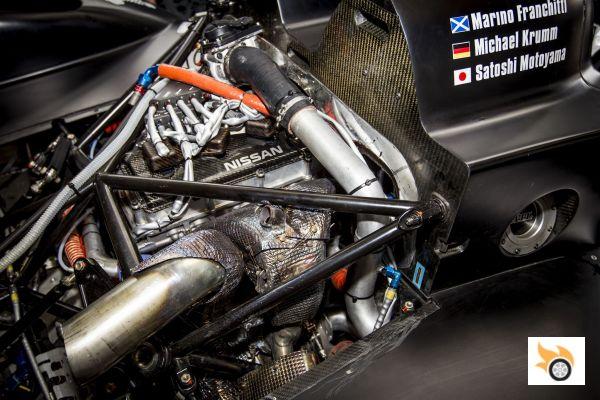
With financial assistance from Nissan, RML created a 1.6-liter, direct-injection, turbocharged engine tailored to the DeltaWing's needs.
And this is where Nisan comes in. It's not clear how, but Darren Cox, Nissan's sports manager, who was hired to bring back the sporty brand image to the Japanese company, was approached by RML. Cox was already a faithful follower of the DeltaWing project, and wanted to give his support to the project with Nissan because it fit within the basic precepts of the company for its new sports programs: Do something different from all the others, do something flashy and media, do something with little budget and innovative.
At the same time, practically (we are not clear if it was before the chicken or the egg, the truth), RML also took the opportunity to sneak the Nissan Juke R project to Nissan, which would also be responsible for making for the Japanese firm.
The fact is that with fresh money from Nissan available, Bowlby could create a specific evolution of the RML engine for Le Mans, with the idea of lightening weight and improve reliability in order to withstand the 24 hours, also offering a flatter torque curve and beneficial to adjust to track conditions and driving requirements of the pilots.
The resulting engine turned out to be much lighter than RML's original, and proven enough to withstand the 24 Hours of Le Mans. With 300 horsepower, 475 kilograms of weight and half the unsprung mass of a typical LMP car, the DeltaWing was capable of 307 mph on the Le Mans straight, 11-lap runs on 40 liters of fuel at La Sarthe (an average fuel consumption of 27 liters per 100 kilometers, well below its rivals), and a 3:42 in 24 Hours qualifying, on par with the best LMP2s.
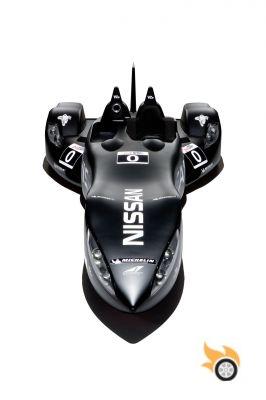
The Cx of just 0.35 makes it one of the lowest drag racing cars in history.
With a Cx of just 0.35, the DeltaWing also took advantage of active aerodynamics, with a Gurney flap appearing in areas where more downforce was needed, such as under braking, on the trailing edge of the rear of the bodywork.
The car was forced to use traditional mirrors, which made the aerodynamics 8% worse, according to Bowlby. Originally, cameras and screens were to be used to replace them. On the other hand, the car was 29th fastest in the Porsche "eses", the most difficult corners for downforce. In any case, the 3:42 was not a demonstration of potential as the ACO made it clear to the DeltaWing team that the car had to run at 3:45 in the race. Any excess in that sense could end up with changes in the design of the car or bigger flanges. So in the race the DeltaWing was not seen to go over that pace. On the other hand, the final gear ratio was not adjusted to Le Mans either, so the top speed could still be improved.
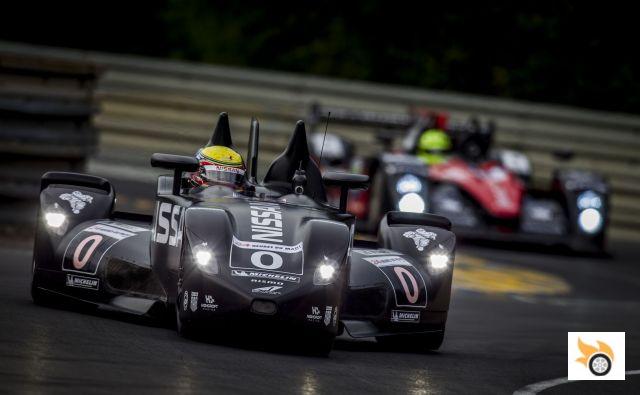
The car turned out to be much faster than expected, so Nissan had to spin it at the ACO's pace of 3:45. The race ended badly after being hit by a Toyota after 75 laps in the race.
The Le Mans experiment, in any case, ended badly. After 75 laps, a spin by Kazuki Nakajia's Toyota TS030 in the Porsche S's ended up with the car being rammed and ending up in the crash barriers. The problem was the colour of the car, which made it not very visible at nightfall, so the story ended badly because of an unfortunate choice of colour.
In any case, Ben Bowlby's point about the low downforce car had been proved. The DeltaWing was rebuilt to take part in the Petit Le Mans with Lucas Ordoñez among its drivers, where it achieved a superb fifth place finish, partly unexpected by outsiders.
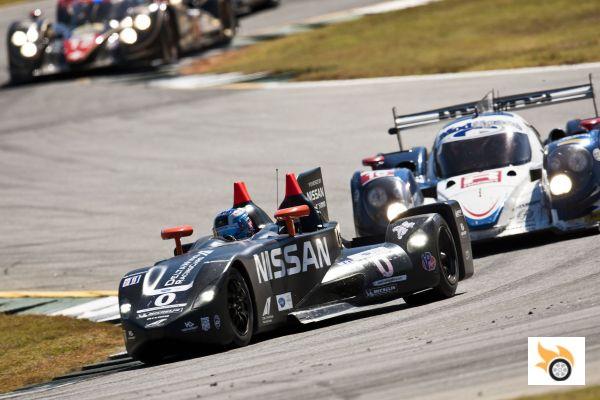
At the Petit Le Mans de Sebring, the DeltaWing achieved a spectacular fifth place finish.
From here, the story of Bowlby, Nissan and the DeltaWing gets complicated. Bowlby wanted to go further with the evolution of his concept, and quickly began to think about how to extrapolate the lessons learned at Le Mans 2012 in a LMP1 for 2015 (which would be called GT-R LM Nismo, does it sound familiar?), but AAR and Don Panoz were not willing to support such a project.
So Nissan brought in Bowlby as a racing technical advisor to work closely with Darren Cox. In 2014 they would line up the Zeod RC, a hybrid-electric evolution of the DeltaWing, while the LMP1 idea was still cooking. But for their part Don Panoz and AAR continued to produce derivatives of the original DeltaWing, fielding them in US racing, while waging legal battles against Nissan for taking their star engineer and ideologue behind the DeltaWing concept in-house.
In the end, in our humble view, DeltaWing and Ben Bowlby are inseparable concepts, the former being the brain child of the latter. Learn today's DeltaWing lesson well, as it will help you a lot to understand the Zeod RC, and especially the reasons behind the GT-R LM Nismo design, which we'll talk about in depth on a technical level next week.
